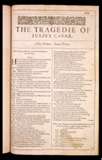Here is the example from the sample page, reproduced here (and in red boldface in its context below):
944-5 One line mCAP2, v1793+ (-RANN, CRK)
All fully collated editions listed in the PW, beginning with the 1793 Variorum edition of George Steevens, emend the copy text at TLN 944-5 to read as a single pentameter line rather than two short ones, so that the end of Portia’s speech and the beginning of Brutus’ occupy the same line, i.e.: “And not my Husbands Secrets? O ye Gods!” The first known example of this reading occurs in Edward Capell’s manuscript notes (c. 1751) for his 1768 edition of the plays, although he does not, strangely, adopt his very own sensible emendation. It is possible that Steevens knew of Capell’s reading, or arrived at it independently. The editors Joseph Rann (1794) and George Lillie Craik (1857) follow F1, and read 944-5 as two separate lines.
878 Y’haue] Ff, Qq, KIT1, ALEX-BEV; you haue mFL, v1773-SING2, COL3, HAL, KTLY, COL4 (subst.); You’ve ROWE1 etc.
879 Stole] Stol’n JOHN, v1773
884 further] farther mFL, Q1691, COL, WH1, HAL
887 wafter] wafture ROWE1-MUN, PEN2, OXF2, OXF4
893 eate] Om. WH1
896 you^] ~ , Qq, F4-YAL1
& Deare^] ~ , F4-POPE2
904 danke] darke F2-F4, QU3, ROWE2, TJOH2; damp WALK
906 Night?] ~ ; TJOH, HAN1, JEN, KNT1+ (-CRK, KTLY, RID)
908 his] hit F1
911 See n. on 919
912 charme] charge TJOH, POPE, HAN1, mCHAUN, WALKER (1860, 3:246) conj., HSS2, HUD2, GOULD (1884, p. 36) conj.
915 your selfe] yourself WALK, THEO3, BLAIR, THEO4-WH2 (-JEN), NLSN, KIT1, MUN, EVNS
916 you are] are you mFL1, OXF1
919-20 One line mCAP2, v1793+ (-RANN, CRK)
919 Ad. Kneele mCOL1 conj., COL2 (subst.); after of in 911 OXF2; SD after 911 OXF4
920 Ad. raising her. mCAP2, CAP, JEN, COL3, PEL2, BEV, OXF4; (after of in 921) [rising] OXF2
921 gentle^] ~ , mTBY4 conj. STAU
923 excepted] expected QU2, QU3, QU4
924 your Selfe] yourself THEO3, BLAIR, THEO4-YAL2 (-CAP [text], JEN, SIS), EVNS, BEV
925 or] of OXF1
926 comfort] consort mTBY2 conj., THEOBALD (1730) in NICHOLS (1817, 2:494) conj., (claimed for THEOBALD in HAN2; claimed THIRLBY in mTBY4), THEO1, THEO2, HAN1, HAN2, mTBY4 conj. M: BLAIR, THEO4, JOHN, CHEDWORTH (1805, p. 276) conj.
927 to] t’ WALKER (1860, 1:221) conj., WH1
sometimes] sometime QU2, QU3, QU4; om. POPE, mHAN, ELZE (1878, p. 347) conj. (withdrawn ELZE, 1889, p. 284)
but in the] but in QU1-QU3, QU4; in the TJOH2; but i’th’ WALKER (1860, 1:221) conj., WH1
933 this secret] your heart mFL
937 Woman well reputed:] Ff, Qq, ROWE, POPE, THEO, JEN, SING, HUD1, CRK, KTLY, CAM1, RLF1, ARD1, RID, CAM3-YAL2, PEN2-EVNS, OXF2; Woman well reputed^ WARB, JOHN; Woman, well-reputed^ v1773, STAU; Woman well-reputed, mCAP2, CAP etc.
944-5 One line mCAP2, v1793+ (-RANN, CRK)
947 a while] awhile CRK, DYCE1, HAL-DYCE2, HUD2-ARD1, KIT1-BOB, BEV, OXF2
949-52 Lines ending engagements; . . . charactery . . . haste. KTLY
949-50 Heart. . . . engagements, . . . thee,] ~ , . . . ~ ; . . . ~ ^ KTLY
952-54 One line mCAP2, v1793+ (-RANN, CRK)
 Textual Notes (TN), TLN 873-952
Textual Notes (TN), TLN 873-952